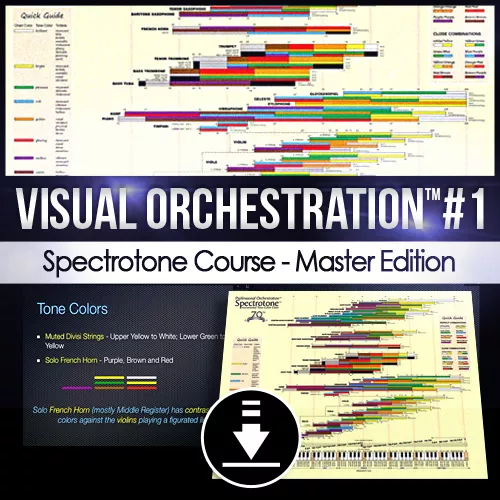
Alexander Publishing Visual Orchestration 1 Spectrotone Course TUTORIAL
The Visual Orchestration™ #1: Spectrotone Course is a short course in orchestration giving you valuable professional scoring information over seven Video Lectures that’s rarely, or if ever taught, in orchestration courses.
Using the included Spectrotone Instrumental Tone-Color Chart™ you’ll learn a boatload of practical writing concepts that you’ll use every time you begin creating music, whether for live ensemble or for MIDI mock-ups.
Stylistically, you can apply Visual Orchestration #1: Spectrotone Course insights to orchestral ensembles (small or large), string quartets and quintets, woodwind ensembles, brass ensembles, trombone choirs, percussion ensembles, concert bands, jazz big bands, horn sections, and MIDI mock-ups when using orchestral sample libraries.
Designed For Those Who Read Music OR Who Learn By Ear
For those who want to learn orchestration by ear, Visual Orchestration #1 is ideal, because it distills the core principles of orchestrating so that the ability to read music is not required. The focus is on the things you do by ear using the Spectrotone Chart as your visual guide. The course combines instrumentation, orchestration, composition and some recording information.
But for those who do read music, you’ll find that Visual Orchestration #1 covers advanced concepts rarely taught in the college classroom, especially in the practical application of counterpoint, and creating combinations.
The Visual Orchestration #1: Spectrotone Course teaches you by emphasizing the aural aspects of orchestration which is the heart of orchestrating – whether you read music or create by ear. That’s because all orchestration, every single bit of it, is done by ear in the musical imagination before ink hits paper or an orchestral sample is triggered by a MIDI keyboard.
The 7 Video Lectures in Visual Orchestration #1: Spectrotone Course
The Visual Orchestration #1: Spectrotone Course has seven video lectures totaling approximately 3.7 hours of instruction. To learn effectively, we’ll be looking at some specific pieces from both the orchestral repertoire and film scores. Click on the Contents tab above to see which pieces you’re recommended to have for listening analysis.
LECTURE 1: Introduction (about 18 mins)
Looks at the beginnings of instrumentation and orchestration; four aspects of music notation separate from the creative process; starting point for the instrumental composer; orchestration’s goal; Visual Orchestration course goals and how they’re achieved.
LECTURE 2: How the Spectrotone Chart Came to Be (about 40 mins)
The four men who influenced Arthur Lange in the creation of the Spectrotone Chart; the origin of Span of Orchestration; why we use C4 instead of C3; what Rimsky-Korsakov started that Arthur Lange finished with the Spectrotone Chart and then some.
LECTURE 3: First Steps in Using The Spectrotone Chart (about 32 mins)
MIDI Note Numbers; Span of Orchestration; instrument ranges; musical language; technical language; Hz frequencies; Span of Orchestration and EQ’ing; Tone Colors; Tone Colors and instrument range; application to the flute and other instruments, muted brass; and the string section as a whole.
LECTURE 4: Orchestral Registration (about 44 mins)
Tone Color transitions; ethnic instruments and the Spectrotone Chart; 3-Part span of orchestration; contrasts by register; melody placement by register; common knowledge; Four Sea Interludes from Peter Grimes, Princess Leia’s Theme; Sayuri’s Theme.
LECTURE 5: Composition With The Spectrotone System (about 27 mins)
Broad music creation paths; a framework for inner listening to compose; melody and figuration; melody in unison or harmony; scoring in 2, 3, and 4 parts; order of listening; contrapuntal rhythmic structure; Basic Instinct, Star Trek Voyager Theme; Jupiter from The Planets.
LECTURE 6: Creating Combinations (about 37 mins)
5 steps to learning combinations; combination definition; secret of coloristic orchestrations; combinations and musical language; combination and technical language; layering in Visual Orchestration; four types of combinations; four types of contrast; finding complementary combinations; remote combinations; combinations and the 8 Keys of Professional Orchestration; compositional decision making; 4 applications with strings; what is orchestration; the need to contemplate.
LECTURE 7: MIDI Mock-ups, Tone Colors and Voicings (about 30 mins)
The dreaded organ/accordion sound; unisons; octaves; the next generation orchestral sample library; tone colors and tonality; Articulation Tables; Sayuri’s Theme, Bizet’s Carmen Suite #1; French horns and ET; Liberty Fanfare; opening to Mendelssohn’s Symphony #4; tone colors and tonality; dominant tone colors for the brass; key points summary; conclusion.
End Results
By the end of the Visual Orchestration #1: Spectrotone Course, whether you read music or create by ear, you’ll have been taught a new common sense tool kit explained in MIDI-speak that can absolutely transform how you currently score, whether for live performance or MIDI Mock-ups.
- Share on Facebook




